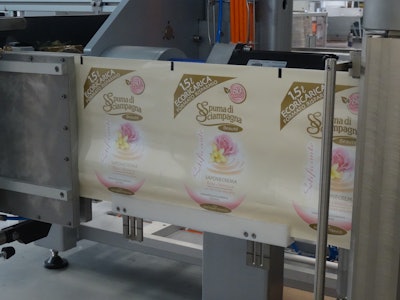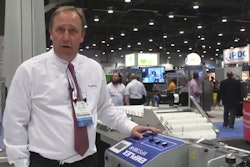
1. Ultrasonic sealing. Some f/f/s machinery manufacturers are debuting ultrasonic sealing capability, which has several advantages over traditional heat sealing. First, ultrasonic sealing has the ability to seal through certain food particulates. Ultrasonic technology suppliers claim this means a drastic reduction in rejected bags and a much lower chance of leakers, a critical issue for oxygen-sensitive products like shredded cheese or lettuce. There is also the potential for film savings. For example, on a typical pillow-style bag made with a laminated structure, traditional heated end seals are typically 3/8 in. wide. But ultrasonic seals are just 2 mm wide. That could mean a savings of more than 1/2 in. per bag. Some industries may be able to reduce the headspace in the finished bag, since having product in the seal area is no longer a concern. This could result in further film savings and machine increases. Also, there’s the potential to reduce or eliminate the sealant layer in film structures, reducing material cost. Finally, ultrasonic sealing systems have the potential to “detect” whether a package has a potentially bad seal by measuring the time and power required to make an acceptable seal. If either parameter falls outside of a preset window, it could indicate a poor seal, allowing the bagger to reject the package for manual inspection. This could reduce or eliminate the requirement in some industries to manually check 100% of bags for leakers, saving labor and increasing throughput. The downside? Not all film structures can be sealed with ultrasonic technology. And ultrasonic sealing adds quite a bit to the system cost when compared with traditional heat-sealing systems.
2. Faster changeover and more reliability. Packagers are focused on reducing both planned and unplanned downtime. This is driving machine builders to reduce the number of adjustments for changeovers on their bagging machines. This can be as simple as adding color-coded centerlining features, clearly marking where to move a given knob or adjustment for precise, repeatable changeover settings throughout the machine. Or it can involve reducing the amount of time required to change a roll of film to less than 60 seconds.
3. Improved sanitation. A heightened focus on food safety has resulted in a demand for equipment that’s easier to keep clean, with fewer or no cracks, crevices, or areas for particles to be trapped. In the dairy industry, a common standard referenced in machine-build specifications is AAA, which concentrates on cleanability, functionality, and durability. The recently implemented FDA Food Safety Modernization Act (FSMA) means that food companies are accountable to the Food and Drug Administration (FDA) to help ensure that their suppliers are making safe ingredients. It has two major themes: prevention and accountability. Prevention means that food companies need to have controls in place during manufacturing to assure the safety of their products and to prevent problems (not just react to them after-the-fact). New cleanability guidelines for food packaging machinery are a big part of the new regulations.


























